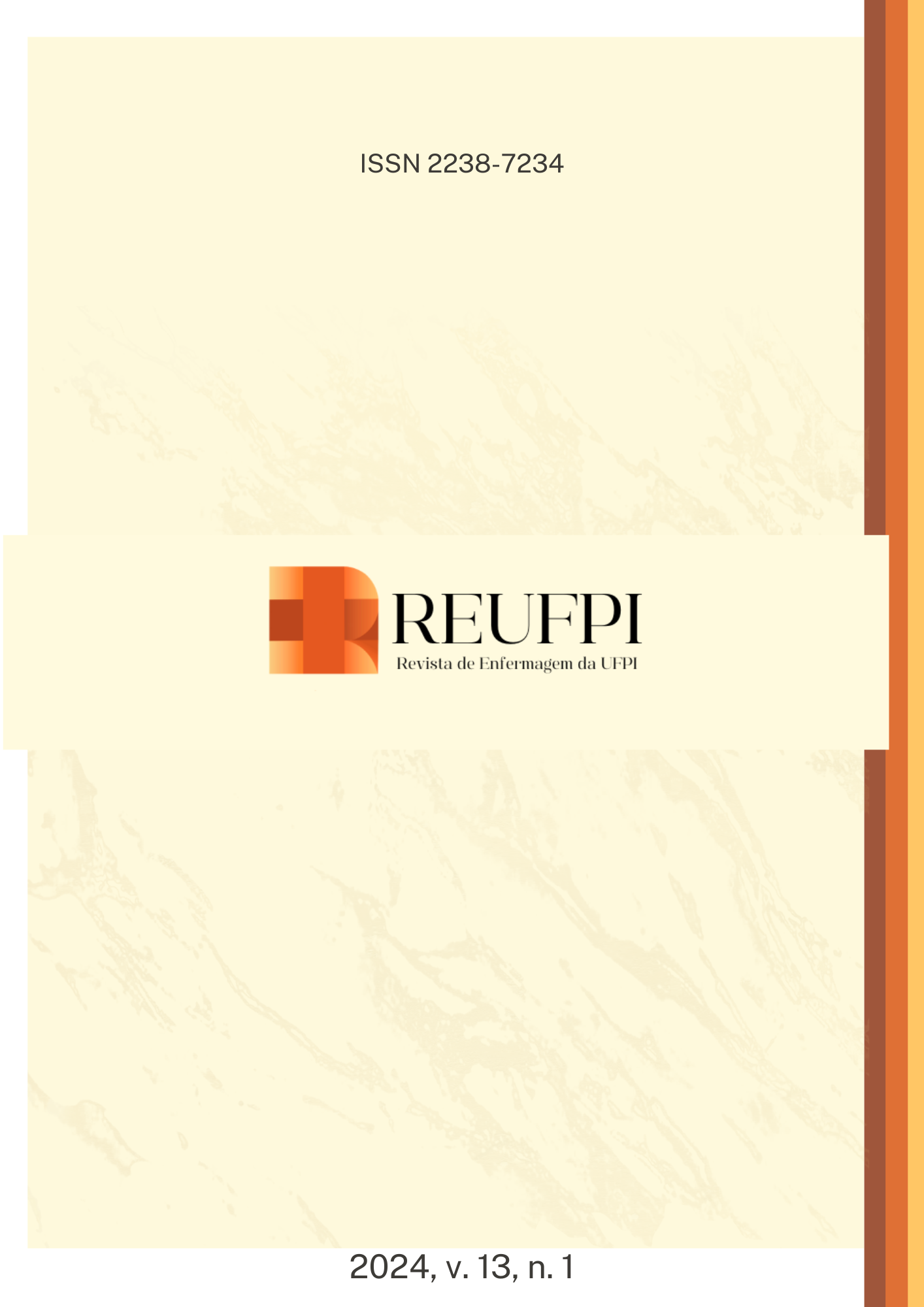Prevenção e manejo de quedas de recém-nascidos hospitalizados: perspectivas de mães e dos profissionais de enfermagem
DOI:
https://doi.org/10.26694/reufpi.v13i1.5137Palavras-chave:
Recém-nascido, Maternidades, Alojamento Conjunto, Acidentes por queda, Segurança do PacienteResumo
Objetivo: compreender as percepções de mães e dos profissionais de enfermagem sobre prevenção e manejo de quedas de recém-nascidos hospitalizados. Métodos: estudo exploratório, qualitativo, fruto de pesquisa de desenvolvimento experimental fundamentada no Design Thinking. Este artigo aborda as etapas de Empatia e Definição realizadas com 20 profissionais de enfermagem e 34 mães internadas no Alojamento Conjunto da Maternidade Pública de Fortaleza em 2023. Para coleta de dados, utilizaram-se entrevista, observação, registros fotográficos e análise documental. Os achados foram submetidos à Análise de Conteúdo no software MAXQDA. Obteve-se aprovação do Comitê de Ética (nº 5.974.647/2023). Resultados: evidenciaram-se 485 unidades de contexto, distribuídas em seis categorias temáticas. Os participantes revelaram incidentes de quedas presenciados/conhecidos, fatores contribuintes (exaustão materna, dormir com o RN na cama ou amamentando, transportar RN no colo, grades dos leitos abaixadas); consequências (traumatismos, fraturas, medo, sensação de culpa); e condutas para prevenção e intervenção (manter-se alerta ao amamentar, elevar grades das camas, manter bebê no berço, transporte seguro, fornecer material educativo para mães). Conclusão: mães e profissionais conhecem os fatores contribuintes e consequências das quedas neonatais, sendo urgente a necessidade de sua integração como protagonistas nas ações de promoção da segurança do paciente.
Referências
Balsarkar G. World Patient Safety Day 2021: Safe Maternal and New Born Care. J Obstet Gynaecol India. 2021;71(5):465-7. doi: https://doi.org/10.1007/s13224-021-01547-1
Ministério da Saúde (BR). Portaria nº 529, de 1º de abril de 2013. Institui o Programa Nacional de Segurança do Paciente (PNSP). Brasília: Diário Oficial da República Federativa do Brasil; 2013. Available from: https://bvsms.saude.gov.br/bvs/saudelegis/gm/2013/prt0529_01_04_2013.html
Driscoll CAH, Pereira N, Lichenstein R. In-hospital Neonatal Falls: An Unintended Consequence of Efforts to Improve Breastfeeding. Pediatrics. 2019;143(1):e20182488. doi: https://doi.org/10.1542/peds.2018-2488
Miner J. Implementation of a Comprehensive Safety Bundle to Support Newborn Fall/Drop Event Prevention and response. Nursing for Women’s Health. 2019;23(4):327-39. doi: https://doi.org/10.1016/j.nwh.2019.06.002
Ministério da Saúde (BR). Sistema de Informação sobre Mortalidade. Brasília: Ministério da Saúde; 2017.
World Health Organization. Handbook for Guideline Development. 2nd ed. WHO; 2018. Available from: https://www.who.int/publications/i/item/9789241548960
Mitchell EA, et al. Falls of newborn infants in a New Zealand hospital: A case series. J Paediatrics Child Health. 2023;59(2):253-7. doi: https://doi.org/10.1111/jpc.16275
Sousa Neto AL, Brito Röder DVDD. Gestão de segurança quanto à quedas de recém-nascidos hospitalizados: uma revisão integrativa. Brazilian Journal of Development. 2021;7(6):57943-55. doi: https://doi.org/10.34117/bjdv7n6-275
Kukielka E, Wallace SC. Newborn falls in Pennsylvania: an analysis of recent events and a review of prevention strategies. Patient Safety. 2019;1(2):51-9. doi: https://doi.org/10.33940/falls/2019.12.5
Scherba JC, et al. Identification of Temporal Variables Surrounding Infant Falls in the Postpartum Unit. Clin Pediatr. 2020;59(14):1290-1292. doi: https://doi.org/10.1177/0009922820942877
Brown T. Design Thinking: Uma metodologia poderosa para decretar o fim das velhas ideias. Rio de Janeiro: Elsevier Ltd; 2010.
Bardin L. Análise de Conteúdo. São Paulo: Edições 70; 2011.
Ministério da Saúde (BR). Conselho Nacional de Saúde. Resolução Nº 466, de 12 de dezembro de 2012. Diretrizes e normas regulamentadoras de pesquisa envolvendo seres humanos. Brasília, DF: Ministério da Saúde; 2012. Available from: https://conselho.saude.gov.br/ultimas_noticias/2013/06_jun_14_publicada_resolucao.html
Silva WC, et al. Análise da ocorrência de incidentes notificados no ambiente hospitalar de uma maternidade pública. Rev Eletr Acervo Saúde. 2019;34:e1445. doi: https://doi.org/10.25248/reas.e1445.2019
Bittle MD, et al. Maternal Sleepiness and Risk of Infant Drops in the Postpartum Period. Jt Comm J Qual Patient Saf. 2019;45(5):337-47. doi: https://doi.org/10.1016/j.jcjq.2018.12.001
Loyal J, et al. Newborn falls in a large tertiary academic center over 13 years. Hosp Pediatr. 2018;8(9):509-14. doi: https://doi.org/10.1542/hpeds.2018-0021
Lakra MS, Lakhkar B. Neonatal fall risk-assessment in hospitals: Are we compromising neonatal safety in developing countries? Sri Lanka J Child Health. 2022;51(2):282-2893. doi: https://doi.org/10.4038/sljch.v51i2.10134
Duthie EA. In-hospital newborn falls associated with a sleeping parent: the case for a new paradigm. Hosp Pediatr. 2020;10(12):1031-7. doi: https://doi.org/10.1542/hpeds.2020-0112
Lipke B, et al. Newborn Safety Bundle to Prevent Falls and Promote Safe Sleep. Am J Matern Child Nurs. 2018;43(1):32-7. doi: https://doi.org/10.1097/NMC.0000000000000402
Carr H, et al. A System-Wide Approach to Prevention of In-Hospital Newborn Falls. Am J Matern Child Nurs. 2019;44(2):100-7. doi: https://doi.org/10.1097/NMC.0000000000000516
Rodrigues GT, et al. Incidentes na assistência das parturientes e recém-nascidos: perspectivas das enfermeiras e médicos. Esc Anna Nery. 2021;25(2):e20200075. doi: https://doi.org/10.1590/2177-9465-EAN-2020-0075
Downloads
Publicado
Como Citar
Edição
Seção
Licença
Copyright (c) 2024 Rev Enferm UFPI

Este trabalho está licenciado sob uma licença Creative Commons Attribution 4.0 International License.
Autores mantém os direitos autorais e concedem à REUFPI o direito de primeira publicação, com o trabalho licenciado sob a Licença Creative Commons Attibution BY 4.0 que permite o compartilhamento do trabalho com reconhecimento da autoria e publicação inicial nesta revista.

























